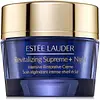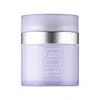What's inside
What's inside
 Key Ingredients
Key Ingredients

 Benefits
Benefits

 Concerns
Concerns

 Ingredients Side-by-side
Ingredients Side-by-side

Water
Skin ConditioningGlycine Soja Oil
EmollientCaprylic/Capric/Myristic/Stearic Triglyceride
EmollientGlycerin
HumectantPrunus Amygdalus Dulcis Oil
Skin ConditioningDimethicone
EmollientStearyl Alcohol
EmollientButylene Glycol
HumectantSteareth-2
EmulsifyingCocos Nucifera Oil
MaskingVitis Vinifera Seed Oil
EmollientGlyceryl Stearate
EmollientNiacinamide
SmoothingPropanediol
SolventSteareth-21
CleansingMoringa Oleifera Seed Extract
Skin ConditioningLimonium Vulgare Flower/Leaf/Stem Extract
Skin ConditioningSodium Hyaluronate
HumectantAcetyl Hexapeptide-8
HumectantLaminaria Digitata Extract
Skin ProtectingLactis Proteinum
Skin ConditioningAcetyl Glucosamine
Skin ConditioningTuna Extract
Skin ConditioningTocopheryl Acetate
AntioxidantCitrullus Lanatus Fruit Extract
Skin ConditioningPersea Gratissima Oil
Skin ConditioningMangifera Indica Seed Oil
EmollientAminopropyl Ascorbyl Phosphate
AntioxidantAlgae Extract
EmollientCaffeine
Skin ConditioningCucumis Sativus Fruit Extract
EmollientPyrus Malus Fruit Extract
Skin ConditioningNarcissus Tazetta Bulb Extract
AstringentSigesbeckia Orientalis Extract
Skin ConditioningButyrospermum Parkii Butter
Skin ConditioningLens Esculenta Fruit Extract
Skin ConditioningSilybum Marianum Seed Oil
Skin ConditioningLimnanthes Alba Seed Oil
Skin ConditioningHordeum Vulgare Extract
EmollientSimmondsia Chinensis Seed Oil
EmollientMacadamia Integrifolia Seed Oil
Skin ConditioningOlea Europaea Fruit Oil
MaskingDextrin Palmitate
EmulsifyingSodium Hydroxide
BufferingCarbomer
Emulsion StabilisingBehenyl Alcohol
EmollientCaprylyl Glycol
EmollientHydroxyethyl Urea
HumectantPropylene Glycol Dicaprate
EmollientCholesterol
EmollientIsoceteth-20
EmulsifyingLactoperoxidase
StabilisingHelianthus Annuus Seedcake
AbrasiveSodium Polyaspartate
HumectantSorbitol
HumectantGlucose
HumectantCetyl Alcohol
EmollientMyristyl Alcohol
EmollientSodium Lactate
BufferingCitric Acid
BufferingSodium PCA
HumectantGlucose Oxidase
StabilisingPotassium Phosphate
BufferingSodium Chloride
MaskingParfum
MaskingDisodium EDTA
BHT
AntioxidantPotassium Sorbate
PreservativeSodium Benzoate
MaskingPhenoxyethanol
PreservativeCI 19140
Cosmetic ColorantCI 14700
Cosmetic ColorantCI 77491
Cosmetic ColorantCI 77492
Cosmetic ColorantWater, Glycine Soja Oil, Caprylic/Capric/Myristic/Stearic Triglyceride, Glycerin, Prunus Amygdalus Dulcis Oil, Dimethicone, Stearyl Alcohol, Butylene Glycol, Steareth-2, Cocos Nucifera Oil, Vitis Vinifera Seed Oil, Glyceryl Stearate, Niacinamide, Propanediol, Steareth-21, Moringa Oleifera Seed Extract, Limonium Vulgare Flower/Leaf/Stem Extract, Sodium Hyaluronate, Acetyl Hexapeptide-8, Laminaria Digitata Extract, Lactis Proteinum, Acetyl Glucosamine, Tuna Extract, Tocopheryl Acetate, Citrullus Lanatus Fruit Extract, Persea Gratissima Oil, Mangifera Indica Seed Oil, Aminopropyl Ascorbyl Phosphate, Algae Extract, Caffeine, Cucumis Sativus Fruit Extract, Pyrus Malus Fruit Extract, Narcissus Tazetta Bulb Extract, Sigesbeckia Orientalis Extract, Butyrospermum Parkii Butter, Lens Esculenta Fruit Extract, Silybum Marianum Seed Oil, Limnanthes Alba Seed Oil, Hordeum Vulgare Extract, Simmondsia Chinensis Seed Oil, Macadamia Integrifolia Seed Oil, Olea Europaea Fruit Oil, Dextrin Palmitate, Sodium Hydroxide, Carbomer, Behenyl Alcohol, Caprylyl Glycol, Hydroxyethyl Urea, Propylene Glycol Dicaprate, Cholesterol, Isoceteth-20, Lactoperoxidase, Helianthus Annuus Seedcake, Sodium Polyaspartate, Sorbitol, Glucose, Cetyl Alcohol, Myristyl Alcohol, Sodium Lactate, Citric Acid, Sodium PCA, Glucose Oxidase, Potassium Phosphate, Sodium Chloride, Parfum, Disodium EDTA, BHT, Potassium Sorbate, Sodium Benzoate, Phenoxyethanol, CI 19140, CI 14700, CI 77491, CI 77492
Water
Skin ConditioningEthylhexyl Palmitate
EmollientMyristyl Myristate
EmollientGlyceryl Stearate
EmollientPEG-100 Stearate
Cetearyl Ethylhexanoate
EmollientDecyl Oleate
EmollientGlycerin
HumectantPropanediol
SolventGoat Milk
Skin ConditioningLactose
HumectantMilk Protein
Skin ConditioningHelianthus Annuus Seed Oil
EmollientHamamelis Virginiana Flower Water
AstringentCocos Nucifera Oil
MaskingPersea Gratissima Oil
Skin ConditioningSimmondsia Chinensis Seed Oil
EmollientVitis Vinifera Seed Oil
EmollientAloe Barbadensis Leaf Juice Powder
Skin ConditioningOryza Sativa Bran Extract
Skin ConditioningRosmarinus Officinalis Leaf Extract
AntimicrobialTocopheryl Acetate
AntioxidantTocopherol
AntioxidantCaprylyl Glycol
EmollientAcrylates/C10-30 Alkyl Acrylate Crosspolymer
Emulsion StabilisingPhenoxyethanol
PreservativeEthylhexylglycerin
Skin ConditioningHexylene Glycol
EmulsifyingXanthan Gum
EmulsifyingAminomethyl Propanol
BufferingDisodium EDTA
Lactic Acid
BufferingBenzoic Acid
MaskingWater, Ethylhexyl Palmitate, Myristyl Myristate, Glyceryl Stearate, PEG-100 Stearate, Cetearyl Ethylhexanoate, Decyl Oleate, Glycerin, Propanediol, Goat Milk, Lactose, Milk Protein, Helianthus Annuus Seed Oil, Hamamelis Virginiana Flower Water, Cocos Nucifera Oil, Persea Gratissima Oil, Simmondsia Chinensis Seed Oil, Vitis Vinifera Seed Oil, Aloe Barbadensis Leaf Juice Powder, Oryza Sativa Bran Extract, Rosmarinus Officinalis Leaf Extract, Tocopheryl Acetate, Tocopherol, Caprylyl Glycol, Acrylates/C10-30 Alkyl Acrylate Crosspolymer, Phenoxyethanol, Ethylhexylglycerin, Hexylene Glycol, Xanthan Gum, Aminomethyl Propanol, Disodium EDTA, Lactic Acid, Benzoic Acid
 Reviews
Reviews

Ingredients Explained
These ingredients are found in both products.
Ingredients higher up in an ingredient list are typically present in a larger amount.
Caprylyl Glycol is a humectant and emollient, meaning it attracts and preserves moisture.
It is a common ingredient in many products, especially those designed to hydrate skin. The primary benefits are retaining moisture, skin softening, and promoting a healthy skin barrier.
Though Caprylyl Glycol is an alcohol derived from fatty acids, it is not the kind that can dry out skin.
This ingredient is also used as a preservative to extend the life of products. It has slight antimicrobial properties.
Learn more about Caprylyl GlycolCocos Nucifera Oil is obtained from the kernels of the coconut fruit. In other words, this is coconut oil.
Coconut Oil is rich in fatty acids with lauric acid making up the majority of these. It also contains linoleic acid. Due to this high fatty acid content, coconut oil helps trap moisture and soften skin.
Despite being antibacterial, coconut oil may not be great for acne-prone skin. It is comedogenic and may clog pores. This ingredient may not be safe for malassezia or fungal acne.
Note: Coconut Oil should not replace your sunscreen for UV protection. Studies show it only blocks about 20% of UV.
This oil is non-volatile and has a light scent.
The term 'fragrance' is not regulated in many countries. In many cases, it is up to the brand to define this term. For instance, many brands choose to label themselves as "fragrance-free" because they are not using synthetic fragrances. However, their products may still contain ingredients such as essential oils that are considered a fragrance.
Learn more about Cocos Nucifera OilDisodium EDTA plays a role in making products more stable by aiding other preservatives.
It is a chelating agent, meaning it neutralizes metal ions that may be found in a product.
Disodium EDTA is a salt of edetic acid and is found to be safe in cosmetic ingredients.
Learn more about Disodium EDTAGlycerin is already naturally found in your skin. It helps moisturize and protect your skin.
A study from 2016 found glycerin to be more effective as a humectant than AHAs and hyaluronic acid.
As a humectant, it helps the skin stay hydrated by pulling moisture to your skin. The low molecular weight of glycerin allows it to pull moisture into the deeper layers of your skin.
Hydrated skin improves your skin barrier; Your skin barrier helps protect against irritants and bacteria.
Glycerin has also been found to have antimicrobial and antiviral properties. Due to these properties, glycerin is often used in wound and burn treatments.
In cosmetics, glycerin is usually derived from plants such as soybean or palm. However, it can also be sourced from animals, such as tallow or animal fat.
This ingredient is organic, colorless, odorless, and non-toxic.
Glycerin is the name for this ingredient in American English. British English uses Glycerol/Glycerine.
Learn more about GlycerinGlyceryl Stearate is a mix of glycerin and stearic acid.
It is used to stabilize the mixing of water and oil ingredients. By preventing these ingredients from separating, it can help elongate shelf life. It can also help thicken the product's texture.
As an emollient, it helps soften skin and supports barrier-replenishing ingredients.
In cosmetics, Glyceryl Stearate is often made from vegetable oils or synthetically produced.
This ingredient may not be fungal-acne safe
Fun fact: The human body also creates Glyceryl Stearate naturally.
Learn more about Glyceryl StearatePersea Gratissima Oil is also known as avocado oil.
Avocado Oil has antioxidant properties. It is mostly made up of the glycerides of fatty acids. About 67% of these fatty acids is made up of oleic acid. Palmitic acid and linoleic acid are also present.
These fatty acids help hydrate and soften the skin. It may increase collagen content in the skin. Collagen helps keep your skin plump and firm. This ingredient helps reduce inflammation and has not shown to clog pores.
This ingredient may not be fungal-acne safe due to its high fatty acid content.
Avocados also have B vitamins, vitamin K, vitamin C, vitamin E, and potassium.
Learn more about Persea Gratissima OilPhenoxyethanol is a preservative that has germicide, antimicrobial, and aromatic properties. Studies show that phenoxyethanol can prevent microbial growth. By itself, it has a scent that is similar to that of a rose.
It's often used in formulations along with Caprylyl Glycol to preserve the shelf life of products.
Propanediol is an all-star ingredient. It softens, hydrates, and smooths the skin.
It’s often used to:
Propanediol is not likely to cause sensitivity and considered safe to use. It is derived from corn or petroleum with a clear color and no scent.
Learn more about PropanediolThis oil comes from the seeds of the desert shrub called Jojoba. It is more commonly known as jojoba oil, a non-comedogenic oil.
Jojoba oil does not contain fragrance and has many fatty-acids, making it a great soothing ingredient.
It also contains Vitamin E, a great moisturizing ingredient. Vitamin E is also an antioxidant and protects your skin against oxidative damage.
This ingredient humectant properties, meaning it helps draw moisture from the air. This helps keep your skin hydrated.
While jojoba has antibacterial properties, it is only able to kill some strains of bacteria.
Studies also show it helps in wound healing. In fact, Indigenous cultures have used jojoba as a moisturizer and to help treat burns for centuries.
Fun fact: Jojoba oil similar to natural human skin sebum, so it has a great effect on dry skin. It is also promising with helping to regulate sebum production.
Due to its fatty acid content, Jojoba oil may not be fungal acne safe. We recommend speaking with a professional if you have any concerns.
Learn more about Simmondsia Chinensis Seed OilTocopheryl Acetate is AKA Vitamin E. It is an antioxidant and protects your skin from free radicals. Free radicals damage the skin by breaking down collagen.
One study found using Tocopheryl Acetate with Vitamin C decreased the number of sunburned cells.
Tocopheryl Acetate is commonly found in both skincare and dietary supplements.
Learn more about Tocopheryl AcetateVitis Vinifera Seed Oil comes from the grape vine. Grape seeds are a byproduct of creating grape juice or wine.
The components of grape seeds have many skin benefits. Research has found it to be antimicrobial and anti-inflammatory. It also contains many potent antioxidants such as Vitamin E , Vitamin C, proanthocyanidins, polyphenols, flavonoids, and anthocyanins. Proanthocyanidin has been shown to help even out skin tone.
Antioxidants help fight free-radical molecules. Free-radical molecules are capable of damaging our cells and other genetic material. Antioxidants help stabilize free-radicals by donating extra electrons. Grape seed extract may help reduce the signs of aging.
The antimicrobial properties of grape seed may help treat acne. However, more research is needed to support this claim.
Grape seed has also been found to help absorb UV rays. Grape seed extract should not replace your sunscreen.
The fatty acids of grape seed oil give it emollient properties. Emollients help soothe and soften your skin by creating a film. This film traps moisture within, keeping your skin hydrated.
Learn more about Vitis Vinifera Seed OilWater. It's the most common cosmetic ingredient of all. You'll usually see it at the top of ingredient lists, meaning that it makes up the largest part of the product.
So why is it so popular? Water most often acts as a solvent - this means that it helps dissolve other ingredients into the formulation.
You'll also recognize water as that liquid we all need to stay alive. If you see this, drink a glass of water. Stay hydrated!
Learn more about Water